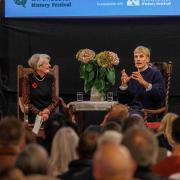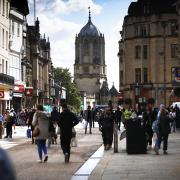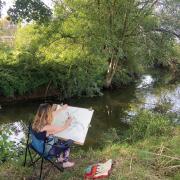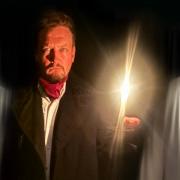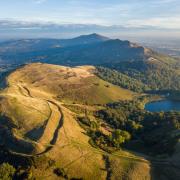Folklorists distinguish two main kinds of folktales. There are the fairy tales, which everyone understands to be stories that have been made up. And then there are the legends. The thing about legends is that people often believe they’re true, even though they’ve largely been made up, and they may have grown from a kernel of real events involving real people. For the historian, legends are jungle of nonsense that has to be cleared away so you can dig down to the facts. For a storyteller, on the other hand, legends are an engaging way of bringing places and past to life. But I have to admit that the egregious promotion of false accounts of events in our own times has made me cogitate about the legends I tell. Made-up stories about times long past may seem harmless entertainment today, but they may well have served somebody’s agenda when they were first told. Might the propagation of them still have consequences we should be alert to, just as we should be alert to contemporary fake news?
A case in point is the farrago of legends about the beginnings of Christianity in Britain, which are interwoven with the Roman conquest that happened at the same time. Most famous is the story that Joseph of Arimathea came to Somerset and built the first British church at Glastonbury; that he brought with him the chalice that Jesus used at the Last Supper; that this became the Holy Grail. But there’s another set of legends in which the Cotswold region is more salient. One of their sources is the 12th-century Oxford writer Geoffrey of Monmouth, who depicts the Romans as invading Britain via Hampshire, with significant events ensuing in and around Gloucester. A more recent elaboration of these legends is an 1861 novel by Samuel Lysons, rector of Rodmarton, entitled Claudia and Pudens; or the Early Christians in Gloucester, which is set during the Roman invasion. Lysons was – confusingly – the nephew of another Samuel Lysons, who discovered at Woodchester the largest known Roman mosaic in Britain. The younger Lysons was an adherent of British Israelitism, a bizarre nationalist movement that claims that the people of the British Isles were descended from the Lost Tribes of Israel. His novel makes heavy use of antiquarian footnotes to impart to his version of the stories a semblance of facticity.

At the heart of these stories was a Cirencester princess – originally called Gwladys, later Claudia – who while studying at the druidic academies of ‘Greeklad’ (Cricklade) and ‘Latinlad’ (Latton) encountered men from Judaea – perhaps Joseph of Arimathea? – who persuaded her, first of all the British, to embrace the Christian faith. Claudia – with her Roman husband Pudens – is named in the New Testament (2 Timothy 4:21); or so we may believe if they be equated with the Claudia – ‘sprung from the blue Britons’ – and Pudens mentioned by the contemporaneous Roman poet Martial. The plot thickens when legend claims that Claudia was the daugher of the leader of British resistance to the Romans – Caratacus – of the daughter of his brother, Togodumnus, thought to have surrendered in the first battle with the Romans. Gwladys could have acquired the name ‘Claudia’ when her father adopted the forename ‘Claudius’ in homage to the Roman Emperor.
Caratacus fought on, but then, according to Geoffrey, agreed to a peace treaty in which, confirmed as king of the Cotswold kingdom of the Dobunni, he accepted the Roman general Plautius as governor and married Claudius’s daughter, Genvissa. In the midst of these events, Claudia met Pudens, one of Plautius’s adjutants. Caratacus was so besotted with Genvissa that he built the city of Gloucester in her honour. A change of governor – to the ruthless Scapula – soon changed Caratacus’s attitude to the Romans. Taking Claudia and Genvissa with him, Caratacus fled across the Severn to take command of the Silurian and Ordovician tribes’ defence of the lands west of the river. The Romans, including cavalry and battle elephants, attempted to cross the Severn mudflats at low tide to Newnham. On the west bank the Silurian druids chanted to the river goddess Sabrina, the warriors yelled abuse at the Romans, and the women showed them their bare bottoms. Sabrina must have heard the druids’ prayers, for the bore wave roared up the Severn and swept to their doom the Roman troops and their animals. Elephant bones have supposedly been found upstream of Newnham as evidence of this event.
This midadventure didn’t stop the Romans. They pursued Caratacus and his followers in a guerrilla war through Wales, until they conclusively defeated him in a battle that in the Forest of Dean is said to have been fought at Symonds Yat, though more likely locations are Caer Caradoc in Shropshire or British Camp in the Malverns. After his betrayal by Cartimandua, Queen of the Brigantes, Caratacus and his family – including Claudia – were taken to Rome, where they were paraded in chains before the Emperor. But Claudius was so impressed by the dignified speech Caratacus delivered that he set them free. Claudia, reunited with Pudens, became mistress of a house in Rome, known as the Britannic Palace, which became a safe haven for Christians, thanks to Pudens’s connection with Plautius. One of their guests was St Paul, who’s said to have travelled to Britain and preached the gospel in the forum at Gloucester where the city’s four main streets meet. Back in Rome, both Paul and Pudens lost their lives in the murderous purge ordered by Nero. Claudia survived to a great age. Her son – or possibly brother – Linus became pope after the death of St Peter.

Caratacus is said to have returned to Britain to be king again in Gloucester. His great-grandson Lucius, king in his turn, asked the Pope to send evangelists to preach Christianity throughout Britain. Lucius received baptism, with many others, and built a church in Gloucester where St Mary de Lode now stands. There he was buried. Some say it was the first church built in Britain, though surely that honour goes to Glastonbury.
One more legend from the Forest tells that on the eve of the Roman invasion the British kings gathered near Staunton to discuss what to do. The druids sought guidance from the rocking of a huge, precariously balanced boulder. The stone told them to sacrifice the first living thing they saw there next morning. What they found was a child of one of the kings. They were about to sickle this child’s throat, when a roebuck leapt over the stone to offer itself in the child’s stead. This young person went on to play an important part in ensuing events. The stone, since known as the ‘Buckstone’, continued to rock on its perch until it was dislodged by some drunken Victorian acrobats.

Precious little of the above can be regarded as trustworthy history. And these stories were coopted by the British Israelite project to define the British as a master race, inheritors of God’s covenant, destined to rule the world. This far-right movement peaked in popularity during the Victorian heyday of the British Empire. Its bogus science, bogus history, and bogus theology have no use today. Yet many of these legends were already part of tradition. They have a romantic appeal that enchants various place you may visit: the Severn mudflats near Newnham, the banks of the Wye below Symond’s Yat, the Buckstone at Staunton, the Cross and St Mary de Lode in Gloucester, the hillfort of British Camp. I’d like to think the stories can be told in a way that’s mindful of political implications and acknowledges they are just stories. Samuel Lysons may have subscribed to British Israelism, but his novel strikes me as equally motivated by love of his native Gloucestershire. Who can know what elements of the legends might just be possibly be true? Somebody had to be the first British Christian! Perhaps a young princess would be more interested in new spiritual ideas than would the battleaxe-wielding warrior kings of that distant time.
FURTHER READING: Gloucestershire Folk Tales by Anthony Nanson; The History of the Kings of Britain by Geoffrey of Monmouth; Claudia and Pudens by Samuel Lysons; ‘Lucius of Britain’ by Alan Smith, Folklore, Vol. 90, No. 1.
Anthony Nanson is based in Stroud and available as a storyteller and speaker. His books include, among others, Gloucestershire Folk Tales and (with Kirsty Hartsiotis) Gloucestershire Ghost Tales and Gloucestershire Folk Tales for Children. He recently completed a PhD on ecological storytelling and storywriting.












